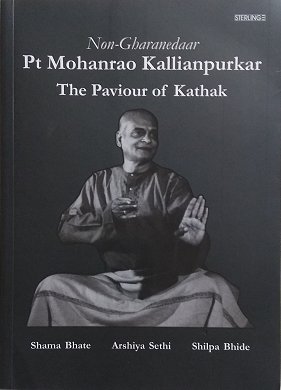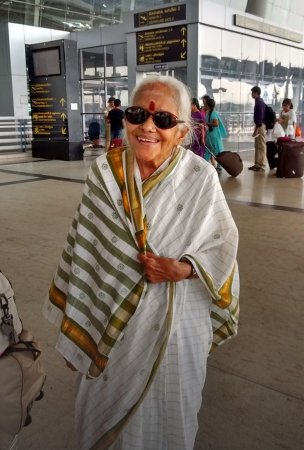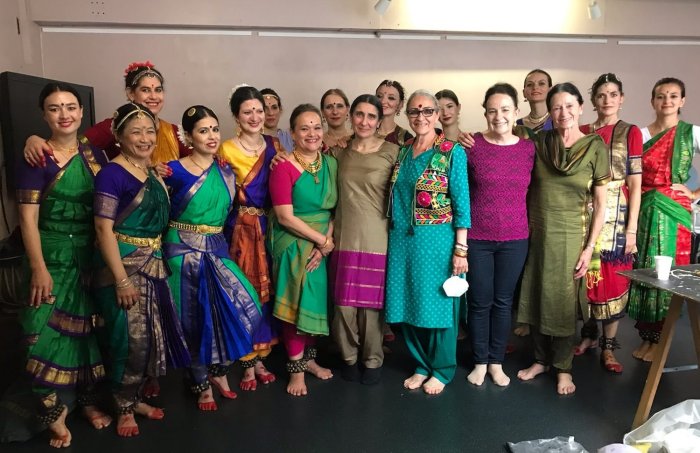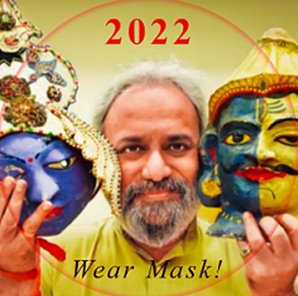
|  |

|  |
 e-mail: khokar1960@gmail.com MK & M.K. June 28, 2022 Mohanrao K for Kallianpurkar - a lesser known strapping man of Kathak, on whom a well-researched book by Guru Shama Bhate and arts activist Arshiya Sethi has just been published by Sterling. He strode tall, figuratively, artistically and literally. Student of Shama tai and polyglot, Shilpa Bhide has strung the tale together, ably. The book is a delight for dance buffs, especially Kathak ones.  Partly because there are so few well written books on Kathak history and fewer biographies. And partly because three authors and it is not a khichdi but a delicious feast. Shama tai brings core competency as a practicing Kathak teacher and choreographer. She also knew the subject personally through her own guru and saasu-ma. Arshiya's long innings in dance field as compere, writer, activist, organiser and two times American Fulbright research experience shows and comes through the meticulous research and lateral studies. She has taken note of even footnotes of Kathak like Gina Lalli of Austin, TX. Nala Najan had introduced me to her way back in the 1990s. Some words chosen are not native to Indian dance writing: paviour, for one, in the title. No, not savior, but someone who paved the way. And artist without an e at end. More on this a little later. The book (Rs.495) is a must-read for dancers. So much recent history comes through and recent history is most complex to write about because sources are still alive and memories, intact. What Baroda says, Bangalore need not agree! Delhi's take on Kathak may not be Doon's (where, incidentally the first huge talent, Nirmala Joshi, settled on Rajpur Road). Caste politics have never interested us Sikhs, who are born casteless. Scholar Chiranjiv Singh once shared: Sikhism is casteless; Sikhs are not! To focus so much on Kallianpurkar's caste shows what? Branding, positioning or chapter filling? Contextualising? This is also a new trend in most universities' dance teaching programs that are aping the West with its jargon in dance writing field, which views even ordinary things from a coloured prism. They will call it variously: gender studies, race or caste. If one wears green glasses, one sees green! Problem with university dance teaching is simple: Not one university has produced a professional dancer of note. Teachers yes, Academicians yes, scholars maybe (most PhDs are fluffs and none have written any books or papers of any lasting consequence) but not performing artistes. I'm talking of Indian universities. And I speak with some authority and experience, visiting some and teaching at some. A few years ago I had mooted the idea of a special issue of attenDance (attendance-india.com) on Dance in Universities of India. Couldn't even find a guest editor. One who wanted to do desperately wanted to window wash her own friends languishing in various universities, so they'd look good, at my expense and endorsement. Wow! I did my own homework and found out that 8 out of 10 didn't amount to much by way of research or papers or books written and the two that did, didn't write or read English! Universities' dance dept. are at best secure teaching jobs now but producing dancers of national repute, none. Maybe one, somewhere! Art is beyond borders or caste. First be an artiste (all through the book artist without an e ending has been used, again very American, because by convention one uses artist for fine arts and with an e at end, for performing) than be anything else.  M.K. Saroja That's what my mother M.K. Saroja taught me. Having just lost her 2 weeks ago (June 13), I was not up to writing any column but this one is 20 years old (my association with narthaki, through various avatars/ columns) and one lesson mother leaves us with is: WORK IS WORSHIP. Jo kaam liya woh pura karo -Professional commitment. She danced in a career of 70 years against many odds, especially rigid structures of South where she was born and brought up; creed of Punjab - being a Madrasi in Sikhdom of sixties when they hadn't crossed the Yamuna - and the need of being in Baroda of the fifties, when they didn't know much of any classical art culture. Add greed of Delhi, the loot-yen city, where all who came, conquered and settled, ultimately became greedy (not needy; that's different) for more. Sarojama is an example of unity in diversity before the term was in use and she is truly pan Indian. Very few artistes left their moorings those days (pre independence) and settled anywhere else, to teach or preach art. At most a guru left their native village to come to a big city, in search of work but not live there forever. Mother was unique. A world traveller without much formal education. I now wonder how she managed at airports those days, alone. What language she used in Afghanistan, Vietnam, Holland or Germany? She didn't talk much, though she was friendly. Often, a line she shared was worthy of a PhD. Like, karta / kaarak, chinta / chintan, even fusion, confusion. She knew and spoke 5 Indian languages but she spoke the language of love, best. Never a harsh word to anyone. She kept friendships and family relationships for life, gave art freely. She never asked for fee. What each student could give comfortably, they gave. A real guru without claiming to be one. Unpretentious doyenne of dance, one art critic had called her once. Divine and humble, others said. When I look at her life in dance, I wonder how she managed teaching in Paris with building and managing a house in Palavakkam? Bringing up 4 kids in 4 parts of India, with different schools and colleges and looking after a husband, who was Punjabi by nature, thus fussy about food too. A pioneer in dance, so same friend field too. How she mixed and merged various cuisines of India, the Gujarati with Kannada, Punjabi with Tamil. She was a natural cook and we were a hungry lot! For each brother, she made the dish or veg they liked. This between rehearsals, teaching and more. Relatives coming to stay for weeks those days, without pre-warning. Even well off dancers like Ram Gopal or Seraikella prince would prefer to stay with us, during Delhi days. And we now, with all machines of comfort, talk of multi tasking! Living in 5 totally linguistically and culturally rich cities of India - Madras, Baroda, Delhi, Jalandhar-Chandigarh and Bangalore and yet always wearing a pleasant smile. Never telling her worries or sorrows to anyone. Never belittling anyone. Never criticizing anyone. Keeping to the course. Come hail or storm. When she finally went, sitting in yogic position, no hospital, no suffering, we just thanked God for sending her our way. The privilege was ours. Loss is for many, whose lives she touched.  Guru M.K. Saroja's students in Paris headed by Vidya Passard, held a homage function on her 13th day at Mandapa, Paris M.K. Saroja was truly pan Indian with much outreach. A good book on her life and times will help document dance history of the last century, from Chidambaram to Champs Elysées. Some films abound, all made abroad. As I write this, I'm not aware if official Indian art agencies even condoled her passing away, which the press did richly nationally. A country is indeed very poor that cannot celebrate its artists or artistes.  Khokar is a critic by profession, historian by education, administrator by experience, archivist by disposition and celebrator of art and artists by spirit. attendance-india.com Responses * 7 decades of teaching and getting Bharatanatyam on the global stage and creating a future for dance through her children and having the first male student from the north creating a huge (unheard of in this era and age) memorabilia of dance over time be her partner .... A Padma Shri is a small recognition. I am blessed to have had her blessings - Ravishankar (June 30, 2022) * Sarojaji was a great inspiration for many of us in France. On stage she projected a striking and vivid energy of love and devotion. She was all generosity, ready to share her art as well as her family life with you if your involvement proved sincere. In my early years in India she was a welcoming and encouraging force that kept doubts and hesitations away. She taught me a mantra that has been and will be with me all the way. For ever grateful. Rest in Peace, beautiful soul. - Annette Leday (June 29, 2022) Post your comments Please provide your name and email id when you use the Anonymous/blog profile to post a comment. All appropriate comments posted with name and email id in the blog will also be featured in the site. |